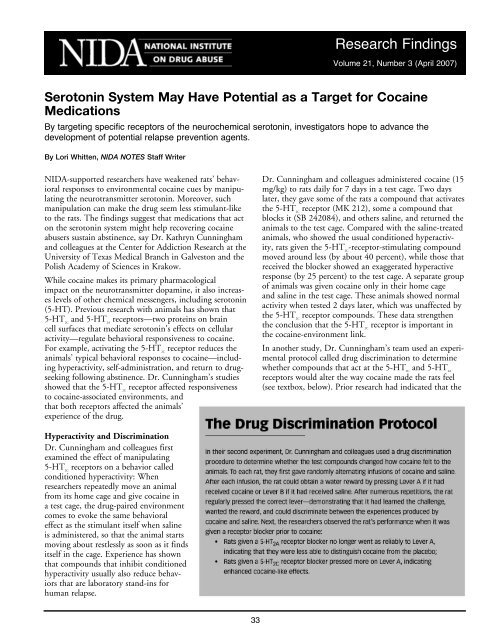Research on Cocaine - Archives - National Institute on Drug Abuse
Research on Cocaine - Archives - National Institute on Drug Abuse
Research on Cocaine - Archives - National Institute on Drug Abuse
Create successful ePaper yourself
Turn your PDF publications into a flip-book with our unique Google optimized e-Paper software.
Serot<strong>on</strong>in System May Have Potential as a Target for <strong>Cocaine</strong><br />
Medicati<strong>on</strong>s<br />
By targeting specific receptors of the neurochemical serot<strong>on</strong>in, investigators hope to advance the<br />
development of potential relapse preventi<strong>on</strong> agents.<br />
By Lori Whitten, NIDA Notes Staff Writer<br />
NIDA-supported researchers have weakened rats’ behavioral<br />
resp<strong>on</strong>ses to envir<strong>on</strong>mental cocaine cues by manipulating<br />
the neurotransmitter serot<strong>on</strong>in. Moreover, such<br />
manipulati<strong>on</strong> can make the drug seem less stimulant-like<br />
to the rats. The findings suggest that medicati<strong>on</strong>s that act<br />
<strong>on</strong> the serot<strong>on</strong>in system might help recovering cocaine<br />
abusers sustain abstinence, say Dr. Kathryn Cunningham<br />
and colleagues at the Center for Addicti<strong>on</strong> <str<strong>on</strong>g>Research</str<strong>on</strong>g> at the<br />
University of Texas Medical Branch in Galvest<strong>on</strong> and the<br />
Polish Academy of Sciences in Krakow.<br />
While cocaine makes its primary pharmacological<br />
impact <strong>on</strong> the neurotransmitter dopamine, it also increases<br />
levels of other chemical messengers, including serot<strong>on</strong>in<br />
(5-HT). Previous research with animals has shown that<br />
5-HT and 5-HT receptors—two proteins <strong>on</strong> brain<br />
2C 2A<br />
cell surfaces that mediate serot<strong>on</strong>in’s effects <strong>on</strong> cellular<br />
activity—regulate behavioral resp<strong>on</strong>siveness to cocaine.<br />
For example, activating the 5-HT receptor reduces the<br />
2C<br />
animals’ typical behavioral resp<strong>on</strong>ses to cocaine—including<br />
hyperactivity, self-administrati<strong>on</strong>, and return to drugseeking<br />
following abstinence. Dr. Cunningham’s studies<br />
showed that the 5-HT receptor affected resp<strong>on</strong>siveness<br />
2C<br />
to cocaine-associated envir<strong>on</strong>ments, and<br />
that both receptors affected the animals’<br />
experience of the drug.<br />
Hyperactivity and Discriminati<strong>on</strong><br />
Dr. Cunningham and colleagues first<br />
examined the effect of manipulating<br />
5-HT 2C receptors <strong>on</strong> a behavior called<br />
c<strong>on</strong>diti<strong>on</strong>ed hyperactivity: When<br />
researchers repeatedly move an animal<br />
from its home cage and give cocaine in<br />
a test cage, the drug-paired envir<strong>on</strong>ment<br />
comes to evoke the same behavioral<br />
effect as the stimulant itself when saline<br />
is administered, so that the animal starts<br />
moving about restlessly as so<strong>on</strong> as it finds<br />
itself in the cage. Experience has shown<br />
that compounds that inhibit c<strong>on</strong>diti<strong>on</strong>ed<br />
hyperactivity usually also reduce behaviors<br />
that are laboratory stand-ins for<br />
human relapse.<br />
33<br />
<str<strong>on</strong>g>Research</str<strong>on</strong>g> Findings<br />
Volume 21, Number 3 (April 2007)<br />
Dr. Cunningham and colleagues administered cocaine (15<br />
mg/kg) to rats daily for 7 days in a test cage. Two days<br />
later, they gave some of the rats a compound that activates<br />
the 5-HT receptor (MK 212), some a compound that<br />
2C<br />
blocks it (SB 242084), and others saline, and returned the<br />
animals to the test cage. Compared with the saline-treated<br />
animals, who showed the usual c<strong>on</strong>diti<strong>on</strong>ed hyperactivity,<br />
rats given the 5-HT2C-receptor-stimulating compound<br />
moved around less (by about 40 percent), while those that<br />
received the blocker showed an exaggerated hyperactive<br />
resp<strong>on</strong>se (by 25 percent) to the test cage. A separate group<br />
of animals was given cocaine <strong>on</strong>ly in their home cage<br />
and saline in the test cage. These animals showed normal<br />
activity when tested 2 days later, which was unaffected by<br />
the 5-HT receptor compounds. These data strengthen<br />
2C<br />
the c<strong>on</strong>clusi<strong>on</strong> that the 5-HT receptor is important in<br />
2C<br />
the cocaine-envir<strong>on</strong>ment link.<br />
In another study, Dr. Cunningham’s team used an experimental<br />
protocol called drug discriminati<strong>on</strong> to determine<br />
whether compounds that act at the 5-HT and 5-HT 2C 2A<br />
receptors would alter the way cocaine made the rats feel<br />
(see textbox, below). Prior research had indicated that the
















